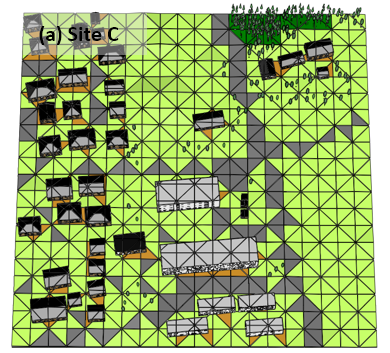Simulation study of the effects of buildings, trees and paved surfaces on ambient dose equivalent rates outdoors at three suburban sites near Fukushima Dai-ichi
Published:

Abstract
The influence of buildings, trees and paved surfaces on outdoor ambient dose equivalent rates (Ḣ*(10)) in suburban areas near to the Fukushima Dai-ichi Nuclear Power Plant (FDNPP) was investigated with Monte Carlo simulations. Simulation models of three un-decontaminated sites in Okuma and Tomioka were created with representations of individual buildings, trees and roads created using geographic information system (GIS) data. The 134Cs and 137Cs radioactivity distribution within each model was set using in-situ gamma spectroscopy measurements from December 2014 and literature values for the relative radioactive cesium concentration on paved surfaces, unpaved land, building outer surfaces, forest litter and soil layers, and different tree compartments. Reasonable correlation was obtained between the simulations and measurements for Ḣ*(10) across the sites taken in January 2015. The effect of buildings and trees on Ḣ*(10) was investigated by performing simulations removing these objects, and their associated 134Cs and 137Cs inventory, from the models. Ḣ*(10) were on average 5.0% higher in the simulations without buildings and trees, even though the total 134Cs and 137Cs inventory within each model was slightly lower. The simulations without buildings and trees were then modified to include 134Cs and 137Cs in the ground beneath locations where buildings exist in reality, and the inventory of paved surfaces modelled as if they had high retention of 134Cs and 137Cs fallout like soil areas. Ḣ*(10) increased more markedly in these cases than when considering the shielding effect of buildings and trees alone. These results help clarify the magnitude of the effect of buildings, trees and paved surfaces on Ḣ*(10) at the un-decontaminated sites within Fukushima Prefecture.
M. Kim, A. Malins, K. Yoshimura, K. Sakuma, H. Kurikami, A. Kitamura, M. Machida, Y. Hasegawa, H. Yanagi
Journal of Environmental Radioactivity 210, 105803 (2019)
DOI: 10.1016/j.jenvrad.2018.09.001
PDF: download
